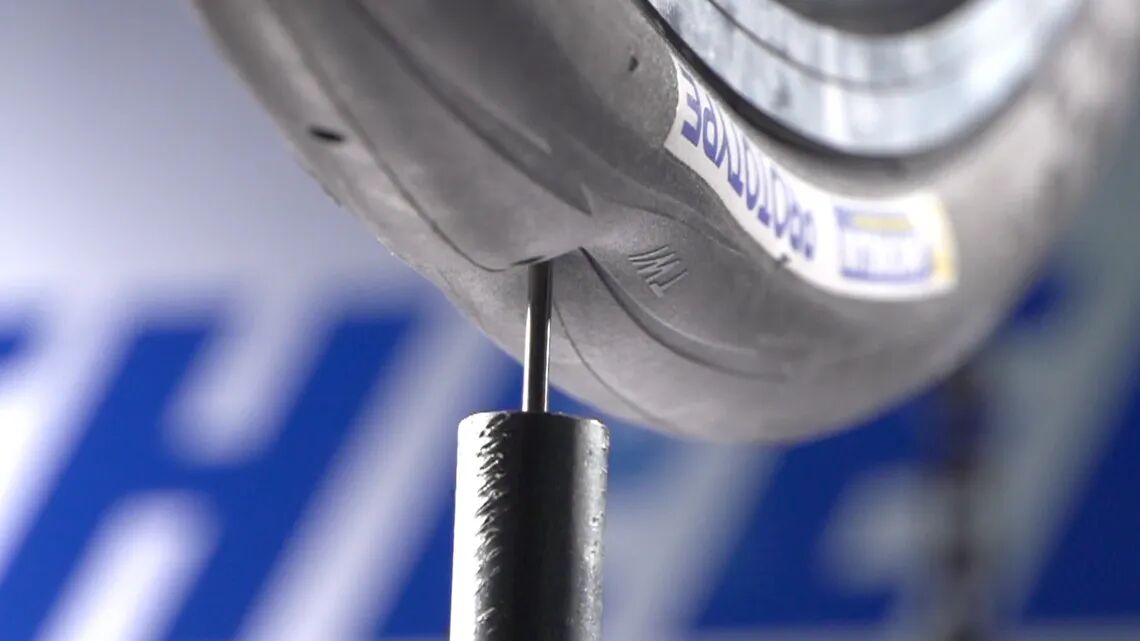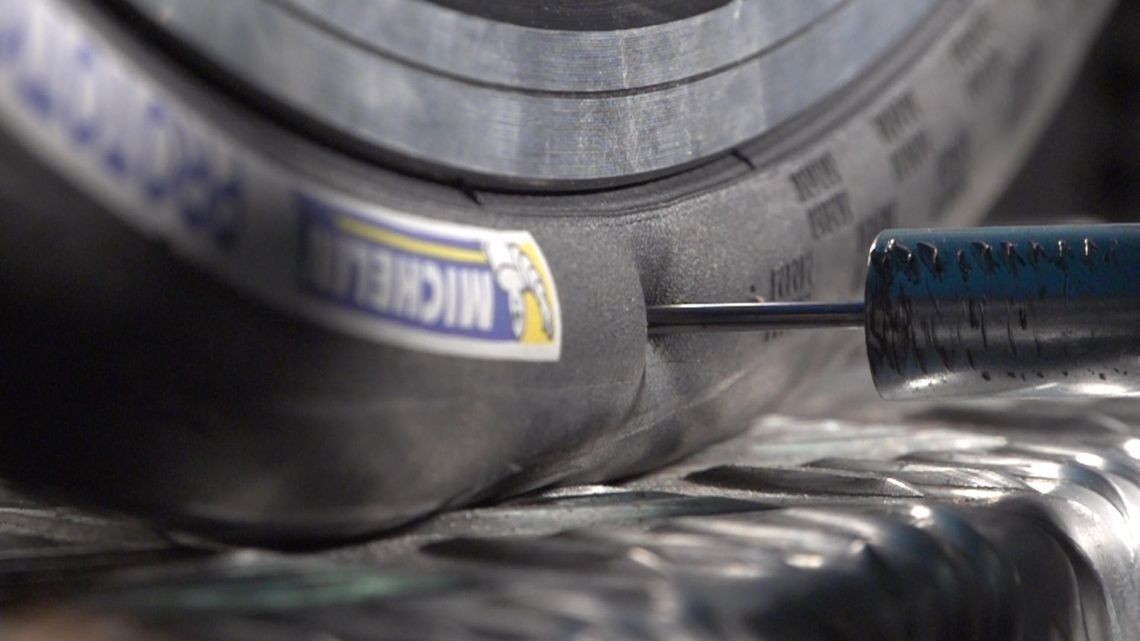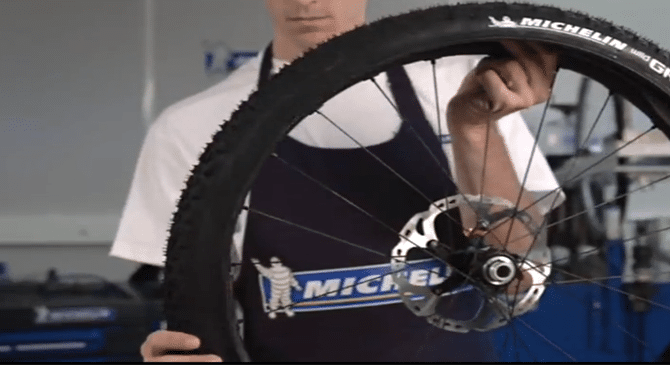How to pump a bike tyre – step by step
Pumping up bike tyres is straightforward if you follow these steps:
Check the recommended pressure for your MICHELIN tyres. Remember that the recommended minimum and maximum pressures indicated on the tyre wall are only valid for mounting the tyre.
Remove the cap from the inner tube valve, keep the cap in order to screw it back on later.
Confirm the type of valve used for the inner tube: Schrader valves are wide and flat, while Presta valves are thin and narrow to a point at the end. There are also 2 less types of valves: Wood and Regina.
Ensure your bike pump has the correct nozzles for the type of valve fitted, otherwise you won't be able to inflate the tyre. Most good bike pumps have nozzles for both valve types.
If the valve has a locking nut on the valve stem – Presta ones will have this feature – you should unscrew it. Either way, tap on the end of the valve to confirm that air is escaping. This also means the inner tube is ready to reinflate.
Connect your bicycle pump to the valve. Some connect directly, while others have a flexible hose for this purpose. Either way, align the pump carefully over the valve to make a proper connection. Don’t try to make a connection while holding the pump is at an angle and thus out of alignment.
Make a good airtight connection with the pump clamped firmly to the valve. You can now begin pumping up the tyre. Be careful to stay in alignment during all the pumping in order to avoid any damage to the valve (specifically with Presta valve).
Work the pump up and down or back and forth, keeping an eye on the pressure gauge to obtain the required pressure reading. Bear in mind the gauge needle will flicker as you pump air into the tyre. So always check the reading when the needle is at rest.
Disengage the pump once the tyre has reached the correct level of pressure. Do this carefully but also quickly to minimise any loss of air pressure. Replace the locking nut, if there is one, and then screw on the valve cap.
Next, move on to your other bicycle tyre, and inflate it too. A good tip is to then go back to the first tyre to check the pressure once more. Any drop in air pressure could indicate you have a slow puncture like a hole in the tube, a defective sealant or a damaged rim base, implying that the tyre needs to be repaired or replaced.
How to pump a bike tyre without a hand pump
Generally speaking, hand pumps are ideal for cyclists because they are small and easy to carry while riding. Some are even designed to clamp onto the frame of the bicycle, which makes them even more convenient. However, you may not have a hand pump available. So, what other ways are there of to pump up bike tyres?
Pump up a bicycle tyre at a petrol station/with a compressor
You may have the possibility to pump up your a bicycle tyre at a petrol station or with an air compressor. If so, you should proceed with extreme caution. As car tyres are often fitted with Schrader valves, an air pump available at a petrol station may be suitable if your bike tyre is also fitted with one. Presta valve connections are not available on such air pumps. However, pumping up bike tyres with such a machine could easily lead to excessive pressure, causing the inner tube to rupture. This could also damage your bicycle and cause injury to anyone nearby. If possible, MICHELIN therefore recommends avoiding petrol station air pumps - unless they have specific settings for cyclists.
Pump up a bicycle tyre with a foot pump
These days, many keen amateur cyclists use a foot pump instead of a hand pump.
How to pump up a bike tyre with a foot pump?
The process is much the same as with a hand pump. The only difference is that a foot pump will stand on the floor once it has been connected to the valve. Then, instead of a manual back-and-forth motion, you pump air by applying a downward push of your foot. Also, these pumps often have a large, clear pressure gauge, which is another useful advantage. The only drawback is that foot pumps are heavier and bulkier than most hand pumps.
Pump up a bicycle tyre with a CO2 cartridge
It is possible to use CO2 cartridges, which are very useful in case of emergency. However, this solution can be dangerous because of the high pressure and instant cooling of the cartridge when it is opened, so the best is to contact a certified professional or the manufacturer to find out what to do.
Why is pumping up bike tyres correctly so important?
Pumping up your bike's tyres to the right pressure is important for three main reasons, which we will explain in detail below.
Better Rolling Resistance
Cycling on a bicycle with flat or under-pressure tyres is much less enjoyable and may be risky especially for road or city use where the surfaces are relatively flat (compared to off-road use where there are many obstacles). Essentially, this comes down to rolling resistance. In other words, when bicycle tyres are low on pressure, they have a flatter profile which creates more friction for the cyclist to overcome. This makes pedalling much more difficult, even on very good surfaces like recently resurfaced tarmac roads. Thus, flattened tyres lead to lower speeds, greater fatigue, and much less enjoyment when riding.
However, this statement must be qualified when it comes to MTB tyres, where under-pressure can be beneficial to the cyclist. Indeed, a good pressure according to the terrain and its numerous constraints (or obstacles) will bring a better compromise between grip, rolling resistance and speed performance.
Better performance
It is even more important to know how hard to pump up bike tyres when the bicycle is used for racing. Without the correct level of pressure, competitors put themselves at a considerable disadvantage. Even strong cyclists who can develop a great deal of power would find it much harder to accelerate and maintain their top speed if the tyres on their racing bikes were not inflated to their optimum level.
Better handling
Finally, pumping up a bicycle tyre correctly is not simply about being able to go faster and further. Both over-inflated and under-inflated bicycle tyres will make handling any bicycle much harder. If you who want to maintain a better grip on the cycling surface, you should be aware that good tyres, such as those manufactured by MICHELIN, must be inflated to their optimal level to maximise handling performance – especially when cornering or braking. Improved handling also means being able to cycle more safely, which is essential, whether it concerns a city bike, a children's bike s, a mountain bike, or a road bike.
You can find more information in our tyre pressure guide.


